Chapter 3
Evidence of Leviathan
At that time the Lord will punish Leviathan, the gliding snake. He will punish Leviathan,the coiled snake,with his great and hard and powerful sword. He will kill the monster in the sea. [Isaiah 27:1, NCV]
This chapter may tax your ability to keep an open mind, as it has mine. But if you dare to believe, the reward may be a new appreciation for both stories in the Bible, and the history of Earth.
The previous chapter discussed the possibility that the real Mount Sinai is a mountain known as Jabal Al Lawz in Saudi Arabia. Most are unaware that the story of the sea-serpent Leviathan in the Bible may culminate near Mount Sinai in the wilderness when the young Jewish nation of Israel camped there.
It was at Mount Sinai that God gave Moses the ten commandments on stone tablets. Moses then built a box called the Ark of the Covenant to hold the tablets, and built a tent called the Tabernacle to house the Ark.
For our purposes here, the interesting fact is that when Moses had the tabernacle constructed, he wrote that they covered it with skin from the “tachash.” Unfortunately, no one seems to know for sure what a “tachash” is, or was, although there are a few surprising clues. If we can unravel this mystery, then it may explain an amazing satellite photograph.
The Real Leviathan
It is possible that the tachash was the actually mega-sea-39
Amazing Evidence: Grounds for Belief monster Leviathan. The book of Job describes Leviathan as the most fearsome creature on the face of the earth, too big to capture, and too powerful to kill. (Job 41).
If we are to make a solid connection between Leviathan and the tachash, we should first investigate a few questions raised by the Biblical accounts and debated among scholars. Was he a myth, or was he real? Was Leviathan only symbolic of satanic forces as many biblical scholars believe, or does the Bible teach that he was a real flesh and blood creature? And ultimately, is there real hard evidence of his existence?
The word “tachash” occurs fourteen times in Exodus and Numbers. The King James translates the word as “badgers.” Yet some more modern translations have interpreted that the tachash was a sea creature. In fact, the NASB calls it “porpoise,” the ASV prefers “sealskins,” and the HNV went with “sea cow.” But it seems that Bible translators have mostly ignored Jewish tradition that suggests the tachash was Leviathan – the large sea serpent described in the book of Job. We can sympathize. Many believe Leviathan was mythical, or at least wasn't around at the time of Moses. It apparently seems less controversial to call the tachash a porpoise than a sea serpent.
The 41st chapter of Job seems to describe Leviathan as an amphibious creature that was flesh and blood, and it details its physical features. Isaiah also briefly describes Leviathan, portraying it as a serpent sea dragon (Is. 27:1). There are also hints in the historical record that Moses may have even been responsible for Leviathan's death, and may have benefited when it became food for the Israelites in the wilderness. The evidence is sparse, but the details are intriguing.
40

Amazing Evidence: Grounds for Belief
The large outer covering of the Tabernacle is prominent in this photo of a full-size replica in Timna, Israel. The original covering was made from the skin of a tachash. (Photo courtesy of Justin Hatch).
First, the “tachash” used for making the tabernacle covering sounds a lot like the word for serpent, which is
“nachash.” The word for sea is “tehowm.” which means “deep sea.” Although it is a bit speculative, when they wanted to say
“sea serpent” it is possible that instead of saying “tehowm nachash” they shortened it to “tachash.”
More evidence for believing that Leviathan may have died near Mount Sinai is found in Jewish tradition. While Moses used the skin of the tachash to cover the tabernacle, rabbis wrote that God will build a future tabernacle, and stretch the skin of Leviathan over it as a covering. It is said that this skin will cover the entire city of Jerusalem, and will glow, lighting the whole world:
41
Amazing Evidence: Grounds for Belief
“What is left of Leviathan's skin will be stretched out over Jerusalem as a giant canopy [tabernacle], and the light streaming from it will illumine the whole world.”
(Legends of the Jews, 1909).
Of course, this prophecy is not from the Bible, and I am not suggesting it is on a par with scripture. Yet it does originate from very ancient writings, and since it is implied that the skin of a mythical Leviathan will be used to cover a future tabernacle, one might surmise that Moses used the actual skin of the real Leviathan to cover the original tabernacle. Since the writer doesn't mention this, we might infer it was common knowledge at the time. Furthermore, it suggests that they believed the pieces left over might be large enough to cover an entire city. Of course, all this hints at the possibility that Leviathan's carcass was available to the Israelites near Mount Sinai, and that it was incredibly large.
Josephus also wrote about the tabernacle covering. While he did not specifically say it was the skin of Leviathan, he did say that it was bright like the color of the sky, which might explain why women desired it for shoes, for the prophet Ezekiel also wrote that the skin of the tachash was used to make shoes, and he suggests that women were particularly fond of them. (Ez. 16:10).
In fact, the same chapter suggests tachash shoes were highly valued, and it compares them to fine linen and jewelry. From this clue, we can conclude that the skin of the tachash was attractive or desirable, and also was tough and long wearing. Other writings also talked about their uses for the skin of Leviathan:
“There were also other curtains made of skins above these, which afforded covering and protection to those that were woven both in hot weather and when it rained.
And great was the surprise of those who viewed these curtains at a distance, for they seemed not at all to differ from the color of the sky.” (Antiquities of the Jews, Book III, Ch. 6).
42
Amazing Evidence: Grounds for Belief The bright color may also explain why the rabbinic writer exaggerated that Leviathan's skin would someday light the world.
A couple of other quotes also seem to place Leviathan near Mount Sinai:
“Nistarot R. Simeon 8 reads: Behemoth will be slaughtered, Leviathan … will be torn by Ziz, and the latter slaughtered by Moses.” (Legends of the Jews, Ginzberg, 1909).
The writer tells us that Moses killed Ziz, a giant bird.
Another reference in the same book states that “the Ziz is as monstrous as Leviathan himself.” Ziz is one of three giant beasts mentioned in the Bible, after Behemoth and Leviathan. It is mentioned twice in the book of Psalms (50:11 and 80:13,14), although almost all Bibles translate it “wild beasts.”
Although it would appear that the author Simeon may have gotten it wrong as to which giant creature Moses killed, a remarkable aspect of the above quote is that it suggests Moses killed some giant creature, presumably near Mount Sinai.
Another reference is a Psalm that King David wrote, which declares that God destroyed Leviathan in the wilderness.
Of course, when the word wilderness occurs in the Bible, it typically refers to the area around Mount Sinai. If indeed God used Moses to kill Leviathan, it could explain why David wrote that it became a source of food, apparently for the Israelites: You divided the sea by Your strength;
You broke the heads of the sea serpents in the waters.
You broke the heads of Leviathan in pieces, And gave him as food to the people inhabiting the wilderness. (Psalm 74:13-14, NKJV)
However, if Leviathan became food for the Israelites, this verse appears to be the only mention of it. And that brings us to 43
Amazing Evidence: Grounds for Belief the present day, and a remarkable satellite image of an area near Jabal Al Lawz in Saudi Arabia.
Can it be real?
Today, many believe Leviathan was just a myth. But if Leviathan was indeed as monstrously huge as legend has it, wouldn't you think that there might some some physical evidence left over today? And this is where the story becomes even more difficult to believe. On February 21, 2008 my son Justin and I stumbled upon a strange shape in a satellite image. Soon after, we posted YouTube videos of the image which together with related videos accumulated more than a million views in the months that followed. The videos can be seen by searching for “mystery giant skeleton” on Youtube.
It all began on a Thursday evening. My son Justin was then a high school teenager helping verify facts for the rough draft of this book. I was adding final touches, or so I thought, when we stumbled on something that would eventually result in another chapter being added to the book. It began as we were looking for biblical artifacts in satellite photographs using Google Earth. As you may already be aware, Google Earth allows one to view satellite photographs of any point on Earth, even your own street, all on a computer screen.
The location we were searching near was Jabal Al Lawz, which as mentioned previously is the mountain in Saudi Arabia that is gaining credibility as the actual site of the biblical Mount Sinai. The mountain may be adjacent to the actual campsite where God led the Children of Israel after they fled Egypt, and it may be the mountain where God issued the Ten Commandments.
An earlier chapter presents evidence that this is indeed Mount Sinai, evidence which includes the mountain's location in ancient Midian, its logical position relative to other key sites, and the fact that biblical artifacts have been found there. Some of these artifacts are visible in satellite images, and it was these that Justin and I were looking for in Google Earth.
44
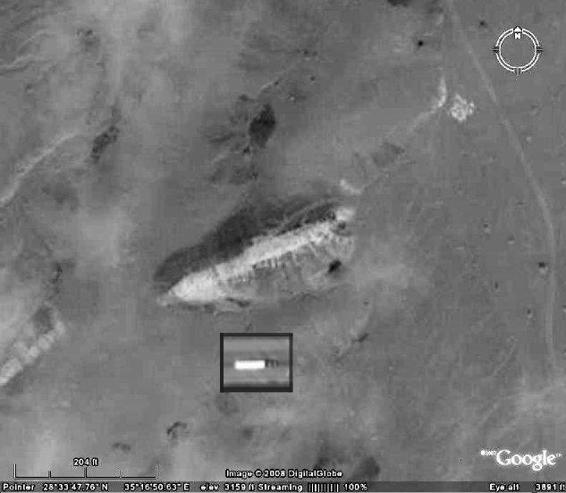
Amazing Evidence: Grounds for Belief After successfully documenting several sites, we were searching northwest of the mountain. Justin was driving −
meaning he controlled the mouse. At one point we headed south, following a dirt road until it disappeared beneath over-hanging clouds. When it re-emerged, we were peering through a thin white haze, although on other image dates the haze was not present.
February 21, 2008 discovery near Jabal Al Lawz in a satellite image. The upper-body portion shown here is the length of a football field. The satellite image of a semi-truck inside the black square reveals how large the skeleton is when viewed at the same scale. The vertical line on the right is a dirt road. Note the shadow and a tail that appears partially buried. (Google Earth image).
45
Amazing Evidence: Grounds for Belief What we saw next was startling. It seemed that we had just passed an enormous skeleton. We both reacted with surprise.
Justin scrambled to return. Before long, we were staring at what appeared to be the skeleton of a giant creature. Our initial amazement gave way to curiosity, so we clicked on the ruler and began measuring. Its length we found to be the size of a football field - about 302 feet by 105 feet. The head alone measured 46
feet in diameter, and even the eyeballs seemed eerily visible. A shadow confirmed that the skeleton rested above ground, and was shaped as one might expect.
And then we noticed what appeared to be broken portions of a serpent-like tail stretching off to the southwest. So we measured between the top of the head and the tip of the tail. In all, it was about 1900 feet long. Next we measured the cross-section of the tail, and it appeared to be about 50 feet in diameter. The entire skeleton was more than one-third of a mile long. Contrast this to the world's largest known dinosaur skeletons, which are typically less than 130 feet, and whale skeletons, which are no larger. In comparison, this object seemed enormous.
As we continued to investigate, we wondered if anyone else had published anything about it. So we launched an extensive Internet search, but after many hours we were unable to find any mention of an unusual skeleton near Jabal Al Lawz. For example, the search lawz "large skeleton" yielded absolutely no results, as did the search lawz "massive skeleton" . Other searches that also came up empty included "skeleton of leviathan", and " skeleton near mount sinai." Searches which were productive did not address this object, and most were displaying images that had been graphically altered, or skeletons of dead whales or fossilized dinosaurs.
In the end, we were left wondering if anyone in today's world was aware of the object. We felt that the fact that our Internet search came up empty was inconclusive at best, because the search was conducted in English. In the years since, however, we have also conducted searches in Arabic, but still without success, except for occasional comments from those who are 46

Amazing Evidence: Grounds for Belief aware of our videos..
We knew that the area was a restricted area, but we also knew that a few individuals had investigated the area – occasionally at great personal danger. However, it raises the question as to whether any of them might have noticed the object. It seems unlikely that a skeleton of this size could have been overlooked entirely by explorers such as Ron Wyatt, Bob Cornuke, Jim and Penny Caldwell, and others. Possibly, those who did notice it did not identify it as the biblical Leviathan, so they chose to remain silent. It should be noted that I sent emails to these persons in an attempt to learn more, but none of them have have responded to date.
Sections of the entire object are visible in this image, stretching from the upper right to lower left. Total length is .36 miles.
(Google Earth image).
47
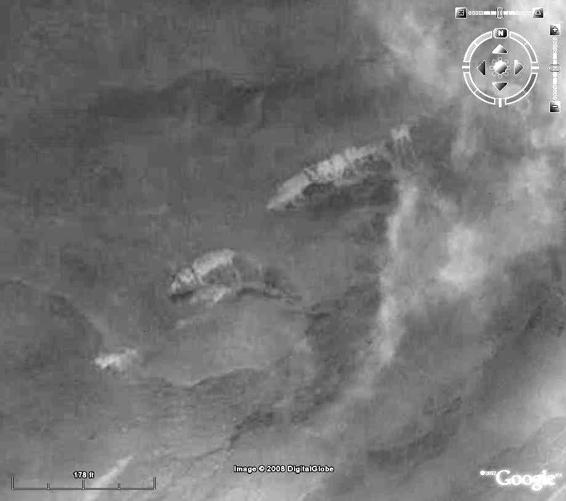
Amazing Evidence: Grounds for Belief Additionally, the fact that the object is in a wilderness area, and the fact that the area is protected by the Saudi military as an archaeological site further reduces the objects exposure to public scrutiny.
Leviathan, the Piercing Serpent
After the Internet, we searched the Bible. Several books in the Bible mention Leviathan, an enormous sea serpent. Since the object had serpent-like proportions, this seemed a good place to begin. The book of Job is probably the most ancient book in the Bible, and it contains the lengthiest description. Here, Job describes the enormity of Leviathan:
Closeup of apparent broken tail segments lying on rocky terrain as viewed through clouds. (Google Earth image).
48
Amazing Evidence: Grounds for Belief
"Can you pull in the leviathan with a fishhook or tie down his tongue with a rope? Can you put a cord through his nose or pierce his jaw with a hook? …. Can you make a pet of him like a bird or put him on a leash for your girls?
Will traders barter for him? Will they divide him up among the merchants? …. If you lay a hand on him, you will remember the struggle and never do it again! Any hope of subduing him is false; the mere sight of him is overpowering. No one is fierce enough to rouse him. "
(Job 41:1-10, NIV)
After studying images of various skeletons, we concluded that the object's physical structure actually resembles an exoskeleton – the type of skeleton sported by insects and crustaceans. The Wikipedia entry for exoskeleton opens with this statement:
"An exoskeleton is an external skeleton that supports and protects an animal's body, in contrast to the internal endoskeleton of, for example, a human."
While some references to Leviathan may be purely symbolic, the description in the book of Job clearly does not seem so. It describes Leviathan as though he were as though he were an actual living sea creature. Also, consider the ways Job's description seem to imply an exoskeleton: Job 41
7 Can you fill his hide with harpoons
or his head with fishing spears?
13 Who can strip off his outer coat?
15 His back has rows of shields
tightly sealed together;
16 each is so close to the next
that no air can pass between.
49
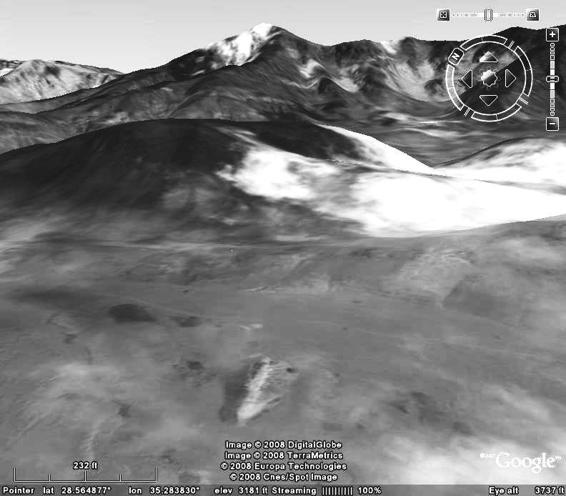
Amazing Evidence: Grounds for Belief 17 They are joined fast to one another;
they cling together and cannot be parted.
23 The folds of his flesh are tightly joined; they are firm and immovable.
24 His chest is hard as rock,
hard as a lower millstone.
26 The sword that reaches him has no effect, nor does the spear or the dart or the javelin.
30 His undersides are jagged potsherds,
leaving a trail in the mud like a threshing sledge.
The object's proximity to Jabal Al Lawz is apparent in this Google Earth image. The white patches are not snow, but rather clouds which were projected onto the ground in Google's 3D
process. The skeleton's flattened appearance is also typical of the way Google Earth processed 3D views in the past.
50
Amazing Evidence: Grounds for Belief Another passage in the Bible also describes Leviathan as a physical, living sea creature.
There is the sea, great and broad,
In which are swarms without number,
Animals both small and great.
There the ships move along,
And Leviathan, which You have formed to sport in it.
(Psalm 104:25-27, NASB).
Notice that the writer compares Leviathan to other
"animals, both small and great," suggesting that Leviathan was a real creature. Also note how the comparison to ships in the sea hints at its great size.
This picture of Leviathan playing in the ocean, together with the “sea serpent” title, and Job's mention of scales has led some to speculate that Leviathan was a fish, but other parts of the description are not fish-like at all. Some believe that the description sounds a lot like a dinosaur or reptile. A chest “as hard as rock,” and an under-belly like “jagged potsherds,” are all inconsistent with a fish. The fact that some have commented that the skeleton resembles an insect also implies an exoskeleton.
One intriguing observation emerges when comparing the following lines from Job 41. Several lines describe Leviathan in the ocean:
1 Can you draw out Leviathan with a hook?
7 Can you … fill his head with fish spears?
31 He makes the deep boil like a pot, he makes the sea like a pot of ointment.
32 He makes a path shine after him, one would think the sea was covered with frost.
However, at least one verse describes Leviathan on land, raising the possibility that it was amphibious:
51
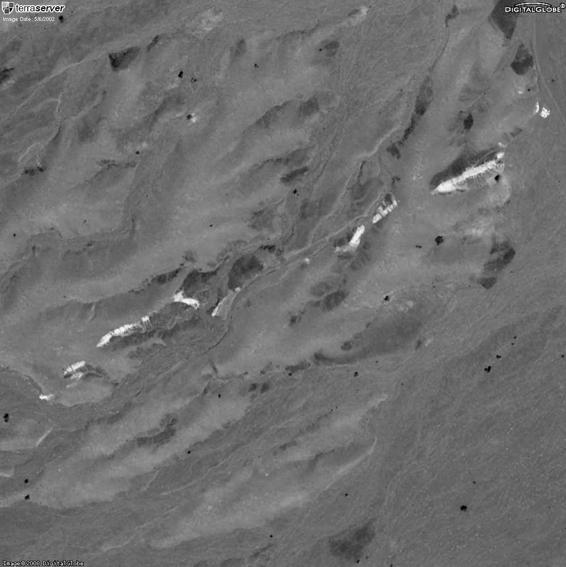
Amazing Evidence: Grounds for Belief 30 His undersides are jagged potsherds,
leaving a trail in the mud like a threshing sledge.
Here is the object in the recently improved view from TerraServer. When placed side-by-side with the Google Earth image, a 3D view can be realized which proves the skeleton rests above ground level, and is not just an optical illusion.
An aspect of Job's description that is difficult to accept is the idea that Leviathan breathed fire. In fact the fire-breathing capability has caused many to consider Leviathan a myth.
So please forgive a little speculation. There is in fact a rather incredible trait of a living creature that might suggest how Leviathan might have been able to breathe fire. The Bombardier 52
Amazing Evidence: Grounds for Belief Beetle squirts boiling liquid from its rear. To accomplish this, it mixes two streams of cold chemicals that create a violent exothermic reaction. A creature like Leviathan might have also mixed two streams of chemicals like the Bombardier beetle, but in this case when the chemicals met they erupted into flames. So while a serpent that breathes fire is clearly outside our realm of experience, it should not be automatically deemed impossible.
The Arrival of Leviathan
It is difficult to imagine how a creature this large could have survived out of water. Engineers, architects, and biologists all agree that with increased size comes exponentially increased stress factors that limit the size of physical objects. These are the same factors that limit the sizes of mountains, buildings, and mammals, but living underwater in a pressure-equalized environment resolves most of these issues and allows for sizes to be larger. For example, the tallest mountains in the world are underwater, as are blue whales, the largest mammals.
Since King David talked about Leviathan's death as though it were a well-known fact, it suggests the skeleton was there prior to his reign. The Hebrew word for wilderness literally means dry places, or desert, exactly the type of environment where this object is located . In fact, the mountains around Jabal Al Lawz are among the driest on earth. The area reportedly experiences less than one-tenth inch of rainfall annually, and is bare of most vegetation and life.
Pictures of Leviathan
More hints that others were once aware of this skeleton comes in the form of art from past centuries. Of particular note is an ancient tile floor in Zippori, Israel. When my son Justin was in Israel, he found that an intricate mosaic image in this floor portrays many events from the Exodus. Incredibly, it shows depictions of Leviathan, Ziz, and Behemoth in the water of the 53
Amazing Evidence: Grounds for Belief Red Sea, implying that all three may have been around during this period.
Other old paintings and illustrations are also included in this chapter that contain similarities to the skeleton that may be more than coincidental. One is an engraving from 1865 by Gustave Dore that depicts Leviathan in a pose similar to that of the skeleton. Another is a magazine illustration from the early 1900s that shows a sea serpent with the shape of the head resembling the one in the satellite images. And a third is from a painting by William Blake around the year 1800 that shows Leviathan dead and looking face up, also in a pose that seems similar to the skeleton. These pictures, like the passages from scripture, present us with the possibility that the skeleton of Leviathan was once known to exist, but that awareness of it may have been lost over the centuries.
Legends and Theories
Besides the Bible, many other ancient sources mention a giant sea serpent. Some of the names attributed to it in various cultures include Tiamat, Nahar, Marduk, Rahab, Azazel, Typhon, and Yacumama. On the other hand, there are at least a few legends of enormous creatures that do not seem to refer to Leviathan. The sea monster Kraken is described as being squid-like, Quetzalcoatl was known as a“feathered serpent” (possibly Ziz), and the biblical Behemoth was said to be ox-like.
54
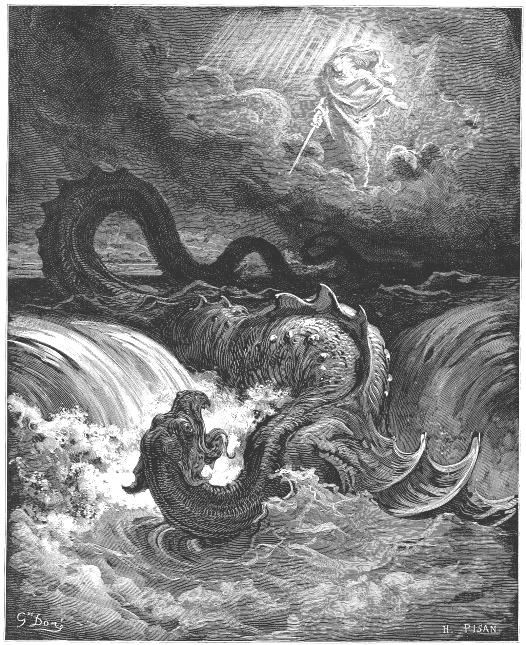
Amazing Evidence: Grounds for Belief
"The Destruction of Leviathan," 1865 engraving, by Gustave Dore. Leviathan's upward gaze is similar to that of the skeleton.
This is probably the best known illustration of Leviathan.
55
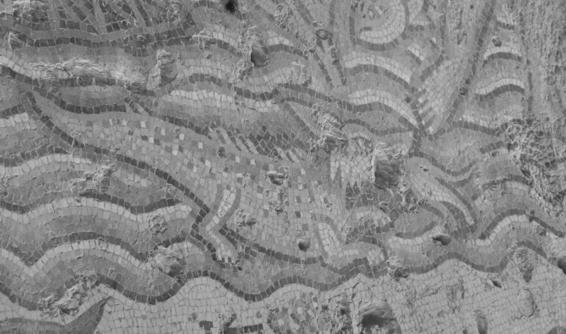
Amazing Evidence: Grounds for Belief This mosaic of Leviathan breathing fire in the Red Sea is on a tile floor in an ancient synagogue in Zippori, Israel, which may date to before the time of Christ. It seems to connect Leviathan with the Red Sea, and the area around Mount Sinai. Another chapter in this book includes more of this image. (Justin Hatch, 2011).
The Book of Enoch states that Leviathan was a female monster that lived in the ocean, and that Behemoth was its male counterpart that lived in the desert area east of Eden. (Charles, 1917). Another rabbinical book from 1837 is titled The Old Paths, and quotes ancient sources at length. Translating directly from Hebrew it states:
"R. Judah said, Rav said, Everything that God created in this world, he created male and female. And thus he did with Leviathan the piercing serpent, and Leviathan the crooked serpent, he created them male and female. But if they had been united they would have desolated the entire world. What then did the Holy One do? He took away the strength of the male Leviathan, and slew the female and salted her for the righteous for the time to come.... (Bava 56
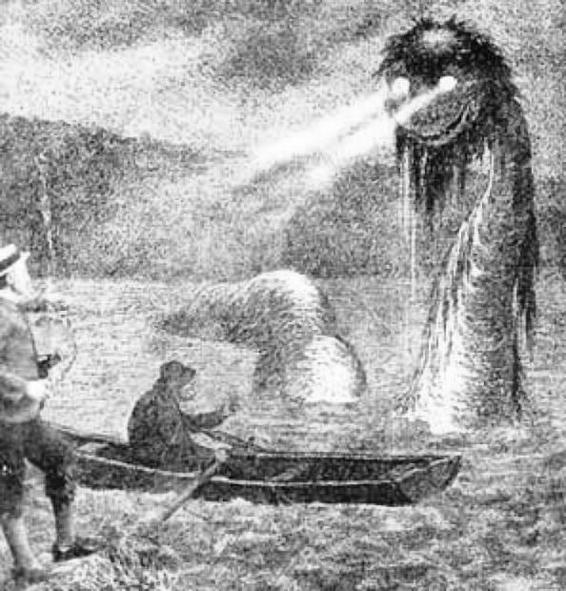
Amazing Evidence: Grounds for Belief Bathra, fol. 74, col. 2)" (McCaul, 1837).
The round head in this old illustration of a sea monster resembles that of the skeleton. According to Job 41:18, Leviathan had eyes that glowed. (Artist unknown).
Another ancient text, the Midrash, is a compilation of Hebrew commentaries. In it we read that Leviathan was created on the fifth day of Creation. It goes on to repeat elements of the previous legend. Rashi, an eleventh century rabbi from France also recited the legend. He commented that the word for sea creatures in Genesis 1:21, actually refers to "sea monsters, crocodiles or large snakes":
"According to legend this refers to the Leviathan and its mate. God created a male and female Leviathan, then killed the female and salted it for the righteous, for if the Leviathans were to procreate the world could not stand before them."
57
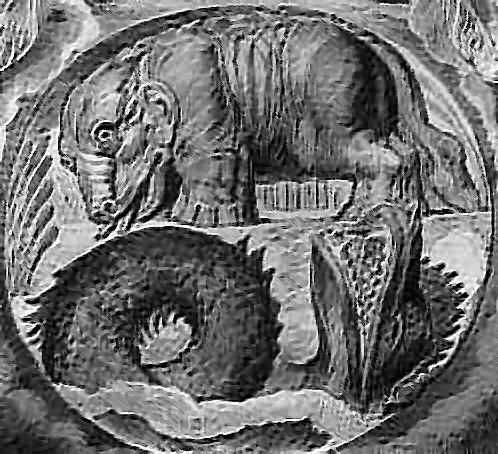
Amazing Evidence: Grounds for Belief If this ultimately proves to be the skeleton of Leviathan, it will be interesting to see how evolutionists deal with it, for it would constitute one more piece of evidence that appears to counter the theory of evolution. If a creature this large evolved here on Earth, where are the fossilized remains of countless generations, not to mention of many similar species?
In this very old painting, Behemoth and Leviathan are shown.
The pose of an apparently dead Leviathan looking face up is similar to that of the skeleton. (Excerpt from painting by William Blake, 1752-1827).
Internet Instructions
For those who are interested in looking at this skeleton in color, the GPS coordinates are listed at the end of this chapter. In 58
Amazing Evidence: Grounds for Belief order to go online to look at it, follow these step-by-step instructions:
Go to www.google.com and click on Maps along the top edge of the screen. A screen with a map of the United States will pop up.
Then, along the top edge of the US map, click on Satellite. A satellite image of the United States will then appear.
Next, type in 28.5634N, 35.2808E in the blank exactly as shown, including the comma. Then press Enter, or click on the Search Maps button.
Finally, to zoom in, click on the second notch from the top of the vertical slider along the left edge of the image.
Of course, there is always the possibility that it is not what it seems. Obviously, finding something in a satellite image, and confirming it in person are two very different things, but until further confirmation emerges it is available for anyone to view in satellite images.
Finally, a postscript. My son Justin recently discovered that www.terraserver.com has updated its images of this area with higher resolution photos, and a cloud-free Terraserver image has been inserted in this chapter. Additionally, we purchased a satellite photo on demand from the QuickBird satellite taken at a 15 degree incline to the first. The result is that a 3-dimensional image of the skeleton can now be seen by placing the two images next to each other and viewing them through stereoscopic glasses.
In the process it has become apparent that the center of the torso is elevated far enough above ground that it appears one could easily park a fleet of trucks under it. Also, in the area that was previously blocked by clouds, it appears there is little new information.
59
Amazing Evidence: Grounds for Belief Also, in order to create a 3D effect that anyone can see without special glasses, I made a video by morphing between the two images, making it seem as though you were moving back-and-forth above the object. The result it that a skeleton-shaped framework emerged that clearly lies above ground that anyone can see on Youtube without the need for special glasses. For those who wish to view the object in this way, search YouTube for the phrase “3D Mystery Giant Skeleton.”
Finally, here is a summary of the evidence in this chapter that suggests Leviathan in the Bible was more than symbolic:
Biblical references place Leviathan near Mount Sinai
Scripture implies the tabernacle covering was made from the skin of a sea serpent near Mount Sinai
A rabbinical writing says that leftovers of Leviathan's skin will be used to make a covering for a future tabernacle, suggesting it was also used for the original tabernacle
A legend states that Moses killed a giant creature
An ancient mosaic image pictures Leviathan in the Red Sea on an ancient tile floor at Zippori
Other more recent artwork seems to confirm various aspects of the Leviathan story were better known in past centuries
Satellite images and 3D image and video show a massive skeleton-like object next to Jabal Al Lawz, the mountain many believe is the Biblical Mount Sinai
At best, the information must still be considered inconclusive, but it sparks the imagination, and may ultimately lead to proof that Leviathan was more than a legend.
Finally, for the do-it-yourself explorer, here are a few coordinates for the skeleton and Mount Sinai that can be entered in Google Earth or Google Maps:
60
Amazing Evidence: Grounds for Belief 1. Mount Sinai
28.5966N, 35.3343E
2. Serpent's head on the west side of the mountain range 28.5632N, 35.2808E
3. Serpent's tail
28.5612N and 35.2757E
* * *
61
Amazing Evidence: Grounds for Belief
*
62
Amazing Evidence: Grounds for Belief Chapter 4
Evidence of Three Days and Three Nights Jesus answered and said unto them, Destroy this temple, and in three days, I will raise it up.
[John 2:19, KJV]
When a group of Pharisees demanded Jesus do miracles he rebuked them, but in the process gave a sign to look for:
"A wicked and adulterous generation asks for a miraculous sign! But none will be given it except the sign of the prophet Jonah. For as Jonah was three days and three nights in the belly of a huge fish, so the Son of Man will be three days and three nights in the heart of the earth." (Matt. 12:39-40 NIV).
Christians believe the sign was fulfilled with Christ's death and resurrection, which they remember on Good Friday and Easter Sunday, respectively. But unfortunately, if Christ died on Friday and rose on Sunday, it doesn't allow for three days and three nights in the tomb. It is a discrepancy which skeptics love, and use to discredit Christian faith.
63
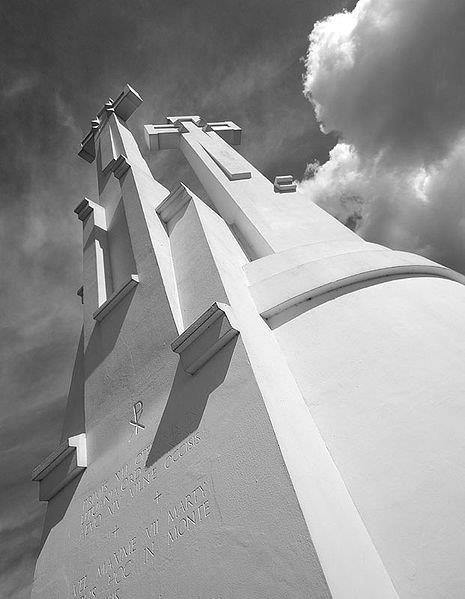
Amazing Evidence: Grounds for Belief A tribute to the three crosses, on a hill in Vilnius, Lithuania.
(Wikipedia Commons).
A number of Bible scholars have attempted to explain the contradiction without really getting to the bottom of it. For example, one argues that Hebrews defined days differently than we do, while another points out that Christ was in the tomb for parts of three days. But such attempts still fall short because they still fail to pass the test of three days and three nights. I appreciate Miss Blue (a.k.a. Blue62) who expressed the frustration well in an online forum:
64
Amazing Evidence: Grounds for Belief
"I have a question that has really bothered me for years. I have asked many people for answers, and no one has been able to give one that I could accept. Although this has nothing to do with my salvation, I still would like to have an explanation.... Jesus was buried just before sunset on the day of preparation for the sabbath on Saturday.... The Gospels say He was already gone when the woman arrived just at sunrise. That adds up to two nights and one day. (blue62, http://www.city-data.com/forum/religion-philosophy/120264-three-days-three-nights.html, accessed 9/2008).
Indeed, on the surface it appears to be a problem. But a genuine solution emerges from an understanding of Jewish traditions.
Although it seems foreign to modern Easter celebrations, a careful analysis of scripture indicates that Good Friday is actually not the correct day to remember the Crucifixion of Christ.
Instead, it occurred on Wednesday. This understanding hinges on three traditions that take the form of twos that resolve all of the questions surrounding this issue:
1. Two methods were used for reckoning 24 hour days. The Roman method begins a 24 hour day at midnight, and it continues untiil the next midnight as does much of the world today. The Jewish method begins a 24-hour day at sundown.
2. Two separate sabbaths were observed that week. Even today, this is true of most Passover weeks. Only in one out of seven years does the Passover sabbath fall on a Saturday sabbath.
3. Two Passover meals were observed that week. This is still true today for those visiting Jerusalem from other regions, as Jesus was.
Of course, the reason for ongoing confusion is that only 65
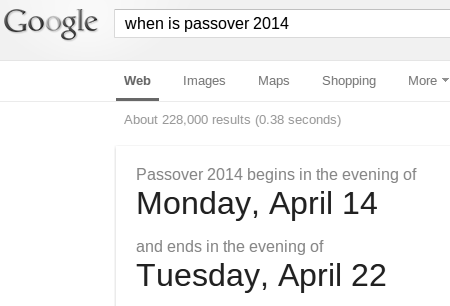
Amazing Evidence: Grounds for Belief the first tradition is widely known among most Christians today.
This is coupled with the fact that the three traditions taken together introduce a degree of complexity on the surface that even modern Jews struggle with. Fortunately, these are traditions that are easy to research because Jews still practice them today.
Two ways to reckon days
Jews at the time of Christ employed two ways for reckoning days. To some extent, it is still true today. Jews at the time of Christ counted hours from sunrise, a habit they learned from the Egyptians during their stay in Egypt: The Ancient Egyptians divided the day-time into twelve hours, numbered one to twelve, and the night-time into another twelve, numbered thirteen to twenty four.
(http://www.kingtutshop.com/freeinfo/Ancient-Egyptian-Calendar.htm).
In this screen snapshot of a Google search, the 24-hour special 66
Amazing Evidence: Grounds for Belief sabbath in 2014 begins at sunset on the evening of April 14.
Of course, modern Jews reckon times from midnight, just as Americans do. But in those days, times were rounded to the nearest 3rd hour, 6th hour, and 9th hour of the day after sunrise.
And then, as if to completely disregard when they started counting hours, they counted days as beginning and ending at sunset, a practice they still observe for reckoning feast days. For example, sabbaths began as the sun crossed below the horizon, and ended 24 hours later, at the same time of day.
Two sabbaths
The reason that we observe the Crucifixion on a Friday is simply because most Christians wrongly conclude that all sabbaths are Saturdays. Yet surprisingly, no scripture supports that view. Instead, scripture clearly implies that the day after the Crucifixion was not a Saturday. The belief has taken root mostly because few Christians understand feast sabbaths. Feast sabbaths always fell on a specific date which may fall on any day in the week, like this one in Leviticus:
"It is a sabbath of rest for you, and you must deny yourselves. From the evening of the ninth day of the month until the following evening you are to observe your sabbath." (Leviticus 23:32).
Moses is talking about a feast sabbath that began and ended at sunset. Furthermore, that day always fell on the 9th day of the month, without regard to whether it was a Saturday or not.
Other days of rest are also specified by date for each of the major Jewish celebrations. And although Moses did not label all of them sabbaths , historically the Jews often call them by that name.
This is primarily because the same rules regarding work and rest apply to these days as to sabbaths. Such sabbaths are also sometimes called special sabbaths, or annual sabbaths.
67
Amazing Evidence: Grounds for Belief We know that the sabbath that began in the evening after the Crucifixion was a feast sabbath, because scripture tells us that Jerusalem was preparing to eat the Passover meal that evening.
Of course, Christ celebrated it the evening before because he was a visitor from Galilee, a tradition we will explore shortly. But numerous verses tell us that the Crucifixion occurred on a day of Preparation, which always preceded a feast sabbath. Here are five problems with the belief that the feast sabbath fell on a Saturday: 1. The odds are against it. Only one in seven feast sabbaths fall on a Saturday.
2. Matthew referred to the sabbath as the "day that followed the day of preparation. If it was a common Saturday sabbath why didn't he just call it “the sabbath.”
3. John also did not refer to it as a typical sabbath when he noted, "that sabbath was a high day."
4. The traditional interpretation has the Galilean women preparing spices before the sabbath. Paradoxically, it has them purchasing them after the sabbath. (Luke 23:54-56, Mark 16:1). Allowing them to purchase and prepare the spices on the Thursday between the two sabbaths solves the dilemma.
1. And finally of course, scripture tells us that Christ was in the tomb for three days and three nights. (Matt. 12:40, 27:62-64; Mark 8:31). The traditional timing only allows for Christ to be in the tomb 36 hours, or 1.5 days, although it includes hours from three days - Friday, Saturday, and Sunday. A Saturday sabbath doesn't allow enough time, creating a simple contradiction.
Understanding there were two Sabbaths resolves most of the misunderstandings that surround the Passion week, and allows for a Wednesday crucifixion. However, there is still one issue that we already mentioned that needs further clarification.
Two Passovers
68
Amazing Evidence: Grounds for Belief In the Gospels, Jesus and his disciples observed both the day of Preparation and the Passover one day ahead of Jerusalem.
The reason for two celebrations was because Jesus was required to observe Passover twice, because he was a visitor from Galilee.
The same tradition is still practiced today.
To understand why, we need to consider how Jews began the new year. Before the age of astronomy and instant communication, Jewish calendars in various cities were frequently one day out of sync with Jerusalem's calendar, and for good reason, because a high level of uncertainty surrounded when the first day of the year actually occurred.
In order to keep the months in sync with the seasons, the Jews had tied the first day of the new year to both the crescent moon and the harvest. For example, the first day of the year was announced at the first appearance of the crescent moon when it was determined the harvest was ripe enough to produce bread in time for Passover. To decide which day that was, the Jews would watch the spring harvest ripen, then would watch the sunset carefully for the first sign of a crescent moon to appear in the evening, following a new moon. The day it appeared would be proclaimed as the first day of the new year, and the first day of the month of Nisan.
So it is easy to see that Passover itself was timed to coincide with the full moon, which occurs fifteen days after the sighting of the crescent moon, and half-way through the 29 day lunar cycle. But it is also easy to see the confusion that might result if different cities judged the crescent moon incorrectly, and wound up with a calendar that was a day out of sync with other localities. In fact, such errors were common.
69
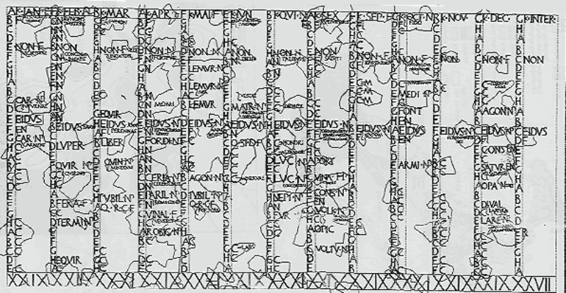
Amazing Evidence: Grounds for Belief
A hand-traced copy of an ancient Roman calendar found near Antium is probably similar to Roman calendars used in Jerusalem at the time of Christ. (Wikimedia).
So in order to gain some semblance of unity, the Jews decided that the date in Jerusalem would be the official one:
"In ancient times, the beginning of a new lunar month had to be determined by direct observation of the new moon.
Among Jews, the only observation that was 'official' was the one certified by the authorities in Jerusalem.... "
(Rabbi Goldwasser, 2008).
However, the differing calendars were an annoyance to some of the more legalistic Jews, because they wanted to be absolutely certain that Jews everywhere celebrated Passover on the date that God considered to be the correct one. So they came up with a creative resolution to the problem.
70

Amazing Evidence: Grounds for Belief The remains of the original Roman Damascus gate. It is likely that Christ was led through this gate on his way to the Cross.
(Deror, Wickipedia Commons).
When establishing the first day of the year, outlying communities would err on the side of detecting the earliest possible crescent moon. They then observed two Passover meals in succession on the 15th and 16th days of their month. This way, they could feel confident that at least one of them coincided with the official 15th day of the month in Jerusalem:
"For this reason, Jewish communities outside the land of Israel adopted the practice of observing an extra day of the pilgrimage holidays (Passover, Shavuot, Sukkot and Sh'mini Atzeret), just in case they had gotten the date of the new moon wrong." (Rabbi Jeffrey Wolfson Goldwasser, http://judaism.about.com/od/holidayssabbath
71
Amazing Evidence: Grounds for Belief
/f/seders_two.htm, accessed 9/2008).
In Jerusalem, however, the Passover meal was only observed on the 15th, since Jerusalem's date was the official one.
The tradition continues even today. Modern Jews living outside Israel observe two Passover feasts − not so much because of uncertainty about the date (although Greenwich time does present a certain paradox), but mainly to keep the tradition. Even today, after the invention of the cellphone, the practice is still widely observed.
So a resident of Israel celebrates only one Passover meal, or seder, while someone living outside Israel celebrates two.
"In the Land of Israel, a Seder is only held on the first night of Passover; and outside of the land of Israel, there are two seders—on both the first and second night."
(Rabbi Azriel Schreiber, 2008).
Christ and his disciples were residents of Galilee when they arrived in Jerusalem at the time of Passover. So even though they were physically in Jerusalem, they were still expected to keep two Passovers. Again, this quaint tradition is still found in modern practice. Even today, visitors to Jerusalem are expected to observe two Passovers:
"If the individual lives in Israel … he or she only does one seder regardless of citizenship. Conversely, if an individual lives in America and is just visiting Israel, he or she would be required to have two sedarim (plural for seder)."
(Rabbi
Azriel
Schreiber,
http://www.
Jewishblogging
.com/blog.php?bid=136602,
accessed
9/2008).
This is exactly the sequence that appears in Scripture.
Since Christ and the disciples had just arrived in Jerusalem from Galilee, they were expected to observe two Passovers, as though 72
Amazing Evidence: Grounds for Belief their calendar was out of sync with the official one, whether it was or not. Evidence that they did this is found abundantly in scripture:
1. They observed Preparation day one day ahead of Jerusalem's Preparation day. (Matt. 26:17, 27:62; Mark 14:12, 15, 15:42; Luke 22:8, 12, 23:54; John 19:14, 31, 42).
2. They observed the Passover supper one day ahead of Jerusalem's Passover celebration. (Matt. 26:17-19; Mark 14:12-16; Luke 22:7-15; John 18:28).
Therefore, the Last Supper was intended to be the first of two Passover meals they would observe. Three of the four Gospels mention that the Last Supper was a Passover meal, while John mentions one the next day. For example, Jesus stated:
"And he said to them, 'I have eagerly desired to eat this Passover with you before I suffer.'" (Luke 22:15).
Yet it is clear that Jerusalem intended to celebrate another Passover the next evening. On the day of the Crucifixion we read that the Jews refused to enter the palace because that would defile them, and they would not be permitted to eat the Passover later that evening. (John 18:28).
73

Amazing Evidence: Grounds for Belief
Old Testament prophecies that compared the coming Messiah to a sacrificial lamb, as in Isaiah 53. (Wikipedia Commons).
More on the Women and the Spices
The women watched with great sadness as the men laid Christ in the tomb. Luke then notes that the sabbath "was about to begin." (Luke 23:54 NIV). The comment reveals that the sun was already setting. Then he points out that the "women who had come with Jesus from Galilee .... went home and prepared spices.
But they rested on the sabbath in obedience to the commandment." (Luke 23:55-56, NIV).
It would be a mistake to think that the women bought and prepared spices on the day of the crucifixion after dark, or on Saturday evening evening after dark. A better interpretation is that they rested on the Passover Sabbath on Thursday, then 74
Amazing Evidence: Grounds for Belief bought the spices and prepared them on Friday. Luke seems to add this comment about when they bought the spices as an afterthought to his account of the crucifixion:
“When the Sabbath was over, Mary Magdalene, Mary the mother of James, and Salome bought spices so that they might go to anoint Jesus’ body.” (Mark 16:1, NIV).
Of course, if you insist that the crucifixion was on Friday you have a problem, because you must visualize that they went out and bought spices after dark on the sabbath, or after dark on Saturday evening, a real problem in the days before markets were illuminated with electric lights, and a highly improbable time for the markets to be open. Then you have to assume that the women went home and frantically prepared the spices during the night or early Sunday morning, before taking them to the tomb However, if you accept that Thursday was also a sabbath, and the Crucifixion occurred a day earlier on Wednesday, then it makes perfect sense that they rested on the Thursday sabbath.
Then they made it an all-day affair to buy and prepare the spices on Friday, before resting again on Saturday and taking the spices to the tomb early on Sunday morning. Buying and preparing the spices on Friday resolves all of the issues.
Dating the Events
These relatively simple insights allow us to determine the date of the crucifixion, which brings us to an amazing epiphany.
In Jewish scriptural tradition, there is unanimous agreement that the Passover lamb was to be slain on the 14th day of Nisan:
“Take care of them until the fourteenth day of the month, when all the people of the community of Israel must slaughter them at twilight.” (Exodus 12:6 NLT).
“Josiah celebrated the Passover to the LORD in 75
Amazing Evidence: Grounds for Belief Jerusalem, and the Passover lamb was slaughtered on the fourteenth day of the first month.” (2 Chronicles 35:1).
The online Jewish Encyclopedia agrees:
The animal was slain on the eve of the Passover, on the afternoon of the 14th of Nisan, after the Tamid sacrifice had been killed, i.e., at three o'clock, or, in case the eve of the Passover fell on Friday, at two. (http://www.
jewishencyclopedia .com /view.jsp?artid=99&letter=P, accessed 3/20/2008).
In Exodus, it is clear that the lamb should be slain on the 14th, which was called the day of preparation. What this does for the timing of the Crucifixion is most inspiring. By the official Jerusalem calendar, Christ was crucified on the day that it was customary to sacrifice the Passover lamb. He then rose from the dead in the afternoon on Saturday, the 17th day of Nisan, the same day that the Israelites crossed the Red Sea, and the most significant date in biblical history as will be further documented in detail in this chapter. Obviously, for Christians everywhere, this timing holds huge symbolic significance.
So with awe-inspiring symbolism, Christ's death on the 14th is perfectly in sync with the command in Exodus to sacrifice the lamb for the remission of sins on the 14th day of the month.
And all four Gospel writers agree that Christ died on the day of Preparation. Matthew lends agreement by noting that the day after the Crucifixion, was "the day after the day of Preparation." Mark, Luke, and John, all simply state that the Crucifixion day was the day of Preparation.
Finally, early on Sunday morning, the women went to the tomb with the spices and found it to be empty. The total elapsed time, therefore, from Christ's death until they found the tomb empty, was three days and four nights. This allowed plenty of time for the scriptures to be fulfilled which say Christ would be 76
Amazing Evidence: Grounds for Belief in the tomb three days and three nights, and it places Christ's resurrection late in the day on Saturday, just before sunset.
There is one remaining issue that needs to be addressed. It is a lone phrase from a verse in the Gospel of Mark. In the KJV it reads, "Now when Jesus was risen early the first day of the week...". (Mark 16:9). The problem it raises is that if Christ was in the tomb exactly three days and three nights, or 72 hours, then he would have risen late in the day on Saturday rather than on Sunday morning. However, Strong's reveals that the Greek word for when is translated after in many instances. In fact, in this specific verse the NASB reads, "Now after He had risen early on the first day of the week...". With this interpretation, this verse no longer presents an obstacle to the possibility of a Saturday resurrection.
God's hand at work
Events leading up to and surrounding the Passion week clearly reveal the hand of God at work. For example, an intriguing pattern is evident when considering the ways that the number three show up. The number three is significant because it is believed to represent the mystery of God. For the sake of emphasis, in the next paragraph the number three will be written numerically as "3." The next paragraph demonstrates that there is a series of 3s that surrounds the Crucifixion, revealing that God was orchestrating the events of the week: In the Garden of Gethsemane, Christ went away and prayed 3 times. Then, Judas betrayed Christ for 30 pieces of silver, resulting in Christ's arrest. After his arrest, Peter denied knowing him 3 times. 3 persons were crucified on 3 crosses, and darkness fell on the land for 3 hours. After 3 days and 3 nights in the tomb, he arose on the 3rd day, which was also the 3rd feast day.
A pattern of 3s is not the only interesting pattern 77
Amazing Evidence: Grounds for Belief associated with the Crucifixion. An even more significant revelation surrounds the third feast day, the day of the resurrection, a date which is especially significant in Jewish history. The day falls on the 17th day of Nisan. Here are seven events that occurred on the seventeenth day of Nisan. Each is accompanied by a comment as to how that event parallels the resurrection of Christ:
1. It is the date Noah's Ark landed on a mountain in Ararat giving the occupants a new beginning. (Genesis 8:4). When the Ark landed, it brought peace and salvation to its occupants. So Christ's resurrection brings peace and salvation to believers.
2. It is the date Abraham's descendants left the famine in Israel and entered Egypt. (Ex. 12:41). By going to Egypt, they were saved from death by starvation, just as Christ's resurrection offers salvation from eternal damnation.
3. It is the date Israel gained freedom from slavery when they crossed the Red Sea (Numbers 33:1-8) saving them from bondage in Egypt. The resurrection of Christ also symbolizes freedom from bondage to sin.
4. The 17th day of Nisan/Abib is the date Israel first ate the first fruits of the promised land (Joshua 5:11-13). The theme is abundant life. The event signifies prosperity and peace, just as Christ's resurrection gives hope of abundant life, both in the here and now, and in eternity.
5. The 17th day of Nisan/Abib is the date King Hezekiah atoned for the sins of the whole nation (II Chron. 29:17-24). It is through Christ's death and resurrection that there is atonement for sin for all of humanity.
6. The 17th day of Nisan/Abib is the date King Xerxes saved the Jews from genocide at Queen Esther's request (Esther 5:1). The 78
Amazing Evidence: Grounds for Belief theme is salvation, just as the resurrection offers salvation.
7. The 17th day of Nisan/Abib is the date Christ rose from the dead. Christ's death and resurrection offers salvation for all, freedom from sin, atonement for sin, and abundant life, both now and for eternity.
So here we see enough spiritual significance in the timing of the Passion Week to practically take your breath away as God paved the way for the most significant event in all history, the resurrection of Jesus Christ, on the 17th day of the year. And contrary to modern observances, we see that Christ was indeed in the tomb three days and three nights.
* * *
79
Amazing Evidence: Grounds for Belief
*
80
Amazing Evidence: Grounds for Belief Chapter 5
A group of Epicurean and Stoic philosophers began to dispute with him. Some of them asked, "What is this babbler trying to say?" Others remarked, "He seems to be advocating foreign gods." They said this because Paul was preaching the good news about Jesus and the resurrection. [Acts 17:18, NIV]
Evidence and Misinformation
Skeptics have long twisted and misinterpreted facts in order to attack the Kingdom of God. A number of atheistic websites actively promote these misinterpretations. Continued propagation by the mainstream media then makes it difficult to effectively counter the errors. Even pastors sometimes unwittingly repeat the false information. The result is that many Christians seem to think that there is little advantage to having faith.
Intuitively, however, Christians know better. Many a Christian can tell you of amazing changes that Christ made in their life. Yet faced with the apparent so-called "facts", they are sometimes left in confusion, unable to explain to others why the discrepancies exists.
81
Amazing Evidence: Grounds for Belief Here is a brief multiple choice test:
1. A marriage
a. is much more likely to succeed between atheists b. is much more likely to succeed between born again Christians
c. the success rate is about the same for atheists and Christians
2. According to a recent study, the happiest people are a. atheists
(Christianity Today, 2006).
b. religious people
c. evangelical protestants
d. Americans
3. Jim Jones of the Guayana tragedy was a self-proclaimed a. pastor
b. atheist
c. communist
d. all of the above
4. The ratio of people who believe they have received a personal message from God is slightly more than
(Gallup, 2008)
a. 1 in 100
b. 1 in 10
c. 1 in 3
5. The percentage of scientists who claim they believe in a God they can pray to and receive answers from is (The Atlantic, 2008) a. 3 percent
b. 19 percent
c. 40 percent
The correct answers in the preceding quiz are 1b, 2c, 3d, 4c, 5c.
In other words, Christian marriages are more successful, Evangelical Protestants are the happiest people, Jim Jones claimed to be a pastor, atheist, and communist, one in three people believe they have received a personal message from God, and an even higher percentage of Scientists claim to believe in a God from whom they can receive answers. Surprised?
82
Amazing Evidence: Grounds for Belief
Statistical Evidence Misinterpreted
Many have misinterpreted surveys by the Barna Research Group to conclude that Christian marriages are more likely to fail than atheistic marriages, but just the opposite is true. George Barna misinterpreted the data, and atheistic websites quickly spread his misinterpretation. Sadly, many Christian publications have also bought into the conclusions without analyzing the raw data firsthand.
The truth is that Christians are more likely to have successful marriages than atheists. The source of the misinterpretation is simple. Even though more Christians have been divorced than atheists, you can't be divorced if you were never married. Fewer atheists marry. So even though more Christians say they are divorced, the success rate for Christian marriages is higher.
Performing a little math on Barna's polling results reveals that for every 100 married atheists, there are about 62 who have been divorced, but for every 100 married Christians, there are only about 33 who have been divorced. These ratios are based directly on the following statistics:
34 percent of atheists are married.
21 percent of atheists have been divorced.
75 percent of Protestant Christians are married.
25 percent of Protestant Christians have been divorced.
Yet in spite of the clear evidence, many Christian leaders have accepted what they are hearing without questioning why it does not agree with experience. Atheists then are free to widely use the misconception in attempts to draw young people away from faith. One example is the web page at atheism.about.com.
The site fails to mention how few atheists are married, yet concludes, "Divorce rates for atheists are among the lowest in America." Of course they are, for their marriage rates are also 83
Amazing Evidence: Grounds for Belief among the lowest. The divorce rates of atheists are meaningless without knowing their marriage rates.
Faith and Personal Happiness
The fact that Christian marriages are more successful is evidence that obedience to Christ to love without condition delivers the abundant life he promised. In fact, statistical evidence repeatedly proves that Christian values do increase personal happiness. However, a number of atheistic web sites present the claim that atheists are happier than Christians. Yet if God visited Earth in the form of Jesus Christ, you would expect his statement that he came to bring abundant life to be both accurate and provable.
Several studies support the fact that those who believe most deeply in Christ's divine origin are indeed the happiest people. While the same studies reveal that involvement in any organization fights depression, it is faith in Christ that defines the happiest people in the world.
More specifically, a recent study found that the happiest people are evangelical protestants who claim to have a personal relationship with Jesus Christ (Pulliam, 2006), and Psychology Today Magazine reported that, "In one Gallup survey, highly spiritual people (who, for example, agree that "My religious faith is the most important influence in my life") were twice as likely as those lowest in spiritual commitment to declare themselves
"very happy." (Myers, 1993).
Declining Church Attendance
Atheists love to point out that church attendance in America has declined two percent in the last decade, and those who identify with the Christian faith has declined even more. The statistics are indeed alarming, and include the fact that Americans calling themselves Christian declined a whopping eight percent between the 1990 and 2000 census, and more recently declined six tenths 84
Amazing Evidence: Grounds for Belief of a percent in one year from 2011 to 2012. But the statistics that the skeptics cite only tell part of the story, for the percentage of people who claim the most committed relationships with Christ seems to be holding steady.
Atheists would like to convince Americans that Christianity is becoming obsolete, but what they are really talking about is a segment of the Christian religious tradition. Cultural diversity is increasing in America at record rates. Our country continues to be a destination for immigrants fleeing poverty and oppression, largely because the strong Christian tradition in the past has turned America into a nation that welcomes strangers, which is a biblical principle. A high percentage of immigrants arrive with other religious backgrounds. But in 2008, even in the face of an influx of non-Christian religions, the percentage of evangelical Christians was not in decline. In this example, the definition of the word evangelical is not defined by any one denomination, but rather by those people who meet specific biblical parameters for saving faith, based upon their response to key questions. The constitution of this sub-group crosses denominational barriers.
"...evangelicals remain just 7% of the adult population.
That number has not changed since the Barna Group began measuring the size of the evangelical public in 1994....less than one out of five born again adults (18%) meet the evangelical criteria. " (N = 1003; margin of error
= ±3.2%).
(http://www.teachingaboutreligion.org/Demographics/non religious.htm, 2008).
In order to determine who the evangelicals were, Barna used objective methods to rate the belief systems of those interviewed. Other surveys generally use more subjective self-labeling methods, which are prone to error. Even more recently, a June 9, 2008 Barna article states, "Evangelicals represent 8% of the adult population...."
85

Amazing Evidence: Grounds for Belief
Chart by Steve Bryce. Based on information from Encyclopedia Britannica. (Bryce, Wikipedia Commons).
So in the face of an increasingly non-Christian makeup of the population, not all segments of Christianity are in decline. In fact, although the statistics are already aged, a number of denominations actually grew between the 1990 census and 2000
census, and people calling themselves non-denominational Christians also grew from 4.7 to 7.2 percent of the population.
This suggests that Christians may be more effectively spreading the gospel than many realize, as they keep pace with the influx, and the fact that even as church attendance and the Christian tradition is in decline, the percentage of those with radical faith may not be.
One reason for not attending church that if often cited in blogs is, “all churches want is your money.” America has become increasingly prosperous, and Paul noted that the love of money is one force that can draw some away from “the faith:”
“For the love of money is the root of all evil: which while some coveted after, they have erred from the faith, and 86
Amazing Evidence: Grounds for Belief pierced themselves through with many sorrows.” (I Timothy 6:10).
Churches would do well to note that money can be a stumbling block for many who might otherwise be drawn into the church. Actions speak louder than words, and many will be offended if a church appears to love money. It may be time for pastors to talk less about money, which is often a thinly veiled appeal for finances. Psalm 127:1 reads, “Except the Lord build the house, they labor in vain that build it.”
Good advice for churches would be to actively trust God by being an example of generosity as you tithe to other ministries, and give to help the poor. I personally served on the board of a church for many years where the pastor embraced this philosophy. The church gave eleven percent to other ministries, and as a general rule the church did not lack funds. The pastor avoided talking about giving, except to cite the church's example.
Conversely, I know of another thriving church that began to see their attendance decline. So they began to speak more about giving. Then, as even more members left, almost every sermon pressed people to give, and more people left. The church is still active today, but has not yet returned to its former size.
Another problem people have with churches is that they always seem to try to manipulate in other ways. Church leaders use guilt trips to get members to fit molds of dress, enthusiasm, and church involvement. On this topic, pastor and motivational author Carey Nieuwhof comments:
“If you’re relying on guilt as a motivator, you need a new strategy. Well, honestly, you’ve always needed a new strategy.”
How much of the decline may be attributed to reasons like this is difficult to tell.
87
Amazing Evidence: Grounds for Belief So what is a true Christian? We do not wish to judge, for only God knows a person's heart, but many call themselves Christians for reasons that don't meet biblical criteria. The Bible talks about a relationship with Jesus Christ as the key to spiritual understanding. It is a relationship that begins with an experience Jesus compared to being born a second time, and it is a decision that requires one reject sinful and selfish ways, and personally invite God to take control. Yet many call themselves Christian because their parents were, or because they know people they admire who are Christian, or because they go to church. But in other ways their lives don't reflect true Christian faith much at all.
The bottom line is that in America, even as church attendance is alarmingly in decline, it appears that the true Church worldwide continues to grow, as followers of Christ love others and tell their story.
Faith and the Intellectual
Skeptics argue faith is blind belief in something for which there is no evidence. Some like to think that if God exists, they would have already found him by means of their superior intellect, but they underestimate God's ability to remain a mystery. The Apostle Paul emphasized that faith is a spiritual gift that only God gives. In other words, to some, God is hidden, to others revealed.
In the Garden of Eden, Adam and Eve enjoyed a close relationship with God, but their sin began a process that removed them from the Garden, and God was no longer as accessible.
Again, when Cain sinned by killing his brother Abel, God hid his face from Cain. The principle is that sin separates humans from God, while choosing purity brings God close.
So when skeptics argue that God cannot exist because they have not experienced him, their arguments carry little weight. An argument like this sounds a lot like someone arguing that California doesn't exist because they have never been there.
Such reasoning should never over-shadow the evidence of faith 88
Amazing Evidence: Grounds for Belief that rests quietly in the background.
Therefore, when skeptics debate they are at a serious disadvantage because they must argue from the position of having never experienced God. Christians, on the other hand, can present testimony of what they know. The atheist must assume that God is not real, simply because God has not chosen to be seen by the atheist.
An example is Richard Dawkins, author of The God Delusion. Dawkins wrote, "I think God is very improbable, and I live my life on the assumption that he is not there." Dawkins honestly admits that the ultimate basis for his argument is an assumption.
The atheist also assumes that Christians are assuming.
And while this is sometimes the case, but it should not be. For many, nothing could be further from the truth. The Christian who is involved in a dynamic relationship with Christ has much more than assumption to go on.
As the Apostle Paul noted, genuine faith is a gift from God. If you attempt to obtain it by any other means than genuine surrender, you become the thief that Jesus described. In his parable, the thief tries to enter the sheepfold by some other means than the door. If that is you, you have discovered the effectiveness of God's security system.
True or False
Like thieves, false prophets are also a danger to the sheepfold. Atheists argue that leaders with religious beliefs are dangerous. But instead, history tells us that atheism and hypocrisy are dangerous.
Jesus Christ warned against listening to dishonest people who claim to be God's messengers, but in reality are not. It is the fruit of a leader, not public statements, that proves where their heart really is.
"Watch out for false prophets. They come to you in 89
Amazing Evidence: Grounds for Belief sheep's clothing, but inwardly they are ferocious wolves.
By their fruit you will recognize them...."Not everyone who says to me, 'Lord, Lord,' will enter the kingdom of heaven, but only he who does the will of my Father who is in heaven." (Matthew 7:15,16,21)
When atheism has been embraced by political leaders, it has often proven dangerous. Leaders like Stalin, and Mao Tse Tung were openly atheistic, while leaders like Jim Jones of Guayana, Adolf Hitler, and others, claimed to be Christians, yet were atheists at heart. For each of them their deception would eventually became a matter of public record.
Absolute Power Reveals
It has been said that absolute power corrupts, but the biblical principle is that absolute power reveals what is already in the heart. And if atheism is in the heart of a dictator, absolute power reveals that the individual is not surrendered to a higher authority.
Some atheists openly declare their lack of faith, but Jesus Christ reserved his most scathing remarks for leaders who pretended to have faith, but actually did not. It was the hypocrites holding positions of authority that he criticized most. These remarks ultimately led the hypocrites to crucify him. It is this type of deception that presents a greater danger to the world.
Many skeptics have said that Adolf Hitler is an example of a Christian with political power, but Adolf Hitler actually had much in common with the hypocrites that Christ condemned.
Early in his campaign, Hitler publicly professed faith in Christ, but privately held different beliefs. The following paragraph from a 1940 edition of Time Magazine reveals the hypocrisy:
“And one of Hitler's first acts as Chancellor was to declare: 'In the two Christian creeds lie the most important factors for the preservation of the German 90
Amazing Evidence: Grounds for Belief people.' Only in secret did he tell his confidant Hermann Rauschning: 'The parsons will be made to dig their own graves. They will betray their God to us. They will betray anything for the sake of their miserable little jobs and incomes. ... I can guarantee that they will replace the cross with our swastika.'” (Time Magazine, Monday, Dec. 23, 1940).
Other signs of Hitler's true beliefs were everywhere. Under Hitler, military personnel were not allowed to express faith in God, the Bible was removed from schools (Straight Dope, 1999) , and Jews were exterminated.
Like Rauschning, others inside Hitler's regime also knew that Hitler was not a Christian. Hitler's secretary, Martin Bormann, declared that "National Socialism [Nazism] and Christianity are irreconcilable". Catholic League President William A. Donohue stated:
"Hitler was a neo-pagan terrorist whose conscience was not informed by Christianity, but by pseudo-scientific racist philosophies. Hitler hated the Catholic Church, made plans to kill the Pope, authorized the murder of thousands of priests and nuns, and did everything he could to suppress the influence of the Church. In 1933, Hitler said, 'It is through the peasantry that we shall really be able to destroy Christianity because there is in them a true religion rooted in nature and blood.'" (Catholic League President William A. Donohue, 1999).
In the New York Times, the Catholic League quoted Hitler as saying, "Antiquity was better than modern times, because it didn't know Christianity and syphilis." (Straight Dope, 1999).
As Hitler's popularity grew, he made other anti-Christian statements. For example, he was quoted attacking Christian pastors in Allan Bullock's book, Hitler: A Study in Tyranny: 91
Amazing Evidence: Grounds for Belief
"I'll make these damned parsons feel the power of the state in a way they would have never believed possible.
For the moment, I am just keeping my eye upon them: if ever have the slightest suspicion that they are getting dangerous, I will shoot the lot of them. This filthy reptile raises its head whenever there is a sign of weakness in the State, and therefore it must be stamped on. We have no sort of use for a fairy story invented by the Jews."
Hitler was known to make statements that hinted at his deception:
"What luck for rulers that men do not think." (Moncur's
#971).
"The great masses of the people... will more easily fall victims to a great lie than to a small one." (Classic Quotes, #29719).
"I use emotion for the many and reserve reason for the few." (thinkexist.com).
"By means of shrewd lies, unremittingly repeated, it is possible to make people believe that heaven is hell and hell heaven. The greater the lie, the more readily it will be believed." (publicquotes.com).
Like Hitler, Jim Jones also mouthed Christian principles in order to push his agenda. Yet, in less public moments, he revealed his deep-seated resentment toward Christianity.
92

Amazing Evidence: Grounds for Belief
These images of Adolf Hitler capture his intensity, and much more. (German National Archives, Wikipedia Commons).
Atheists often cite Jim Jones and the Guyana massacre as evidence that Christianity is dangerous, but the real message from the Guayana massacre is that atheism is dangerous. On the surface, Jones was pastor of the Peoples Temple, and was affiliated with the Disciples of Christ denomination – yet he often made statements promoting atheism, humanism, Marxism, and communism.
Yolanda Crawford was a member of Jones' community in Guyana, South America for three months in 1977. In a sworn affidavit dated April 11, 1978, she asserted that Jim Jones' often made atheistic statements:
"On numerous occasions I was in the congregation when he told us “I am God” and “there is no other God, and religion is the opium of the people.” He stated he used religion only to get to the masses." (http://jonestown.sdsu.
93
Amazing Evidence: Grounds for Belief edu/AboutJonestown/PrimarySources/concerned3.htm).
An atheistic leader is not likely to adhere to the Ten Commandments. Additionally, they do not believe there is a higher power who will ultimately judge them. They therefore may not balk at lying and deception. They may not have a problem with saying they are a Christian, if and when that furthers their agenda.
Atheists seem to assume that Christians have the same sets of core values that they do. Most argue Christians are moral only out of fear, or because they want to get to heaven. Few atheists accept altruism as a valid principle governing behavior.
Altruism is the belief that someone might do something good with no thought of what they might gain from it. The closest they can come to understanding it is to equate the human emotion of compassion with love. As a result, atheists seem unable to discover genuine altruistic love for others.
Genuine love is a little secret gem hidden deep within the Christian faith. It springs from the fact that a relationship with Christ releases a person to embrace altruism through the power of the Holy Spirit. So, to an atheist, the principle of genuine love remains an enigmatic mystery, but to a genuine Christian, it is so obvious it is a moment of duh.
Generally speaking, atheists make other profound errors.
They assume that everything that can be experienced, they have experienced. They assume that all religions are essentially the same. And they assume that the things that motivate them personally are the same things that motivate all persons. Thus, they assume that all motivation is selfish, religion is just another bias, Christians willingly stoop to deception, and altruism doesn't exist. As a result, they ultimately must dismiss the testimonies of the most innocent and honest people as fabrications. They must assume that when testimonies reveal things atheists have not personally experienced, they must be lies. And therefore, in the words of Jesus Christ, they are blind. More precisely, they have been blinded to the reality of God.
* * *
94
Amazing Evidence: Grounds for Belief




















